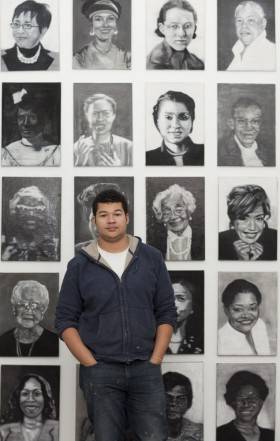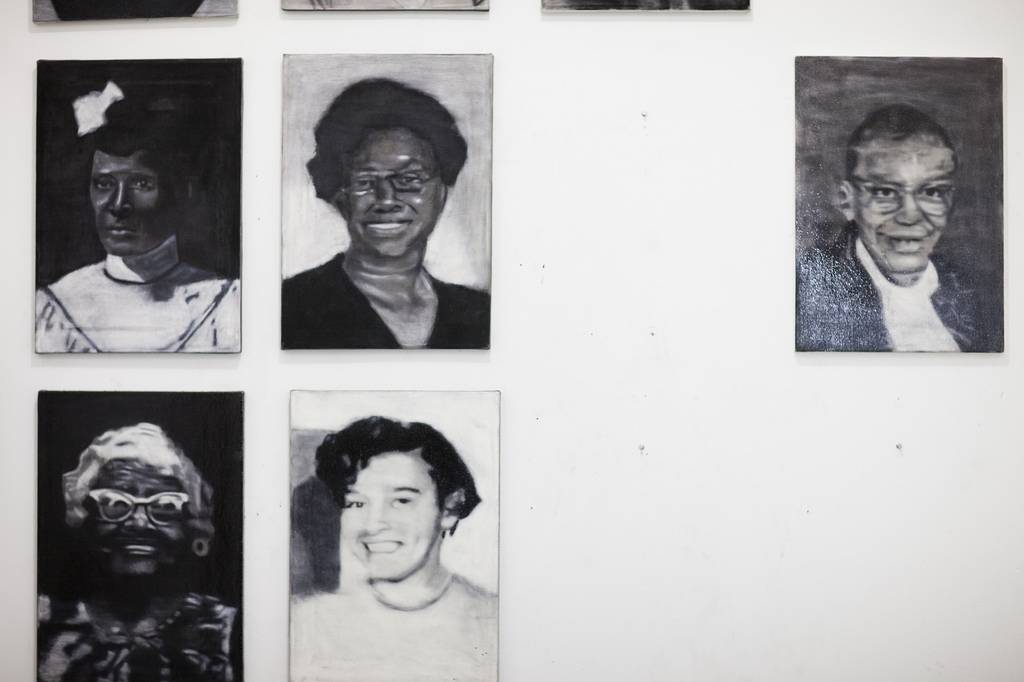23 Portraits | Thursday 7–9 p.m. (artist talk at 8) | Murphy Gallery @ UIUC YMCA | Free
The last time I interviewed Jason Patterson, he was preparing to show his recently finished Civil Rights Project at Indi Go Gallery. Over the course of our interview, I became more and more excited to see his work in person. In Civil Rights Project Patterson seemed to engage a subject that has been teetering on the edge of clichedom, from a relevant (dare I say fresh?) perspective by casting his audience as a television watcher, a magazine reader, a passive cultural voyeur whom he confronts with larger than life representations of iconic images from the golden age of protest.
In his new show, 23 Portraits, Patterson’s focus moves from the grandiousity of that era to the component parts of our community here in Champaign-Urbana, specifically some of the local African American women who have, over time, helped make us who we are. Yet in departing from the largeness of Civil Rights Project (both its form and its content), Patterson has embarked on something that is in many ways much bigger. From what I have seen, this most recent show explores the importance of collective individualism while recognizing the common cultural attributes that connect his subjects to one another. All of his subjects are women, all of them black, all of them tied to C-U in some way, and yet when we encounter them as Patterson presents them to us, we see these women not only as individuals, but as people to whom we are connected by simple virtue of our locale.
Needless to say, I’m pretty stoked about this show too.
Leading up to this, his second major local show in as many years, Jason took some time to chat with me about what prompted 23 Portraits, it’s supposed randomness and his own personal definition of success.

Your show, 23 Portraits, (opening Thursday at the YMCA on campus) features what else but 23 portraits of influential African American women from Champaign-Urbana. Can you talk a little bit about where you came up with this idea?
This series is a study after German artist Gerhard Richter’s 48 Portraits. He did the series for the German pavilion at the 1972 Venice Biennial. This is one of my favorite works by Richter. Even though he was understandably ridiculed for it somewhat. It being 48 portraits of white European men. So for my series last year, Civil Rights Project, I was planing on making a sub series also called 48 Portraits. This would have been 48 portraits of great African American women.
So, doing the same thing as Richter, but with subjects that couldn’t be more opposite. I only got about 8 done before other projects took over. But this year Kasey Umland and Ann Rasmus of the University’s YMCA asked me to show my work in their Murphy Gallery. I was allowed to show whatever I wanted and so I thought, it being Black History Month and then March being Women’s History Month, this would be an excellent reason to finish my 48.
I did a little more research and found that Richter did 48 because that number fit the German pavilion at the ’72 Biennial. 48 was a good number to divide by. Thinking about that and also thinking I could make the subjects more relevant or special to CU and the U of I, I decided to do great black women from Champaign-Urbana and or the U of I.
I choose 23 based on the YMCA’s Murphy Gallery Layout. There are 4 walls and a spot above the fire place. Five portraits will go on each of the 4 walls and 3 will go above the fire place. The 3 represent the two towns and the U of I. Maudelle Brown Bousfield, the first African American women to graduate from the U of I. Phyllis Clark, Urbana’s City Clerk. And Erma Bridgewater a community activist and city worker who has spent her 98 years of life working for the people of Champaign.
So with your number set at 23, how did you decide on which women in town to use as subjects?
Some of the women I had to pick, like the three mentioned before and a few others. But besides those I tried to be as random as possible. There are far more than just 23 great black women from this area that could’ve been in this project. And also I didn’t want it to seem like a “best of” list. But I guess you only know that after I’ve told you the women were picked randomly.
Did you have any of them pose for you, or did you work with pictures?
I got 20 of the images from the internet, three from printed images, one or two of internet images were video stills and the rest were jpegs. I wanted all the images to be found, and found as contemporarily as possible (i.e. the internet). This was a major concept in the series. I am a big advocate of “painting is dead”. Or more specifically, subjective painting is dead. The question “if you can take a picture of it, why paint it?” makes sense to me. So I make drawings OF photos or video stills in hopes people look at these images more objectively. These pieces are drawings of jpegs, mpeg stills or printed photos before they are drawings of these women. I want these pieces to be about how we see images.
Which of your subjects was the most challenging to represent? Why?
The Erma Bridgewater piece was hard. I don’t think it was because the image was difficult. I drew all these on a grid which made it relatively easy. I think it was because it was a later piece and my nerves were getting the best of me. I made, all together, 26 portraits in 44 days. I normally did one, sometimes two, pieces a day when I was able to work. The Bridgewater piece took two days.
Is it fair to ask you which portrait is your favorite?
I have a lot of favorites. But if i had to pick one it would be that Bridgewater piece. The image is her senior high school portrait from the 30s and i just love how it turned out. The greatness behind that women helps too.
I see that in most of your pieces, you only show your subjects face, but in your portrait of Janice Harrington, you have your gesturing with her hands. Any reason for that?
That’s was the best one I could find on Google. I really wanted as many of these images to be found through Google searches. There were a lot of images of Harrington but this one gave me the best opportunity to make an objective drawing. You can see Sybil Mobley’s hand too. I really like that piece.
 How do you see this installation as connecting to previous work?
How do you see this installation as connecting to previous work?
The idea came from the series I planned to do with Civil Rights Project. And basically all my work in the last 3 years has been about drawing and painting found images objectively.
This is your second major gallery show in as many years. You’ve also shown your work in a smattering of coffee shops and other public spaces. From an outside perspective, it seems like you’re a pretty successful guy, but I’m curious to know how, on a personal level, you go about gauging your own success?
I gauge success on happiness. If you count my 9 to 5 job (working in an art store) along with my art work, I work about 12 to 16 hours a day, and I love it. I’m very happy with the my work. So I suppose I am successful in that context. But no, I do not make much money from my work. And for now I’m okay with that. I can support myself and make the work I want to make. The way I see it, you can’t beat that.
———
Patterson’s work will be displayed at the Murphy Gallery at the Y on campus through March.
Photos by Christa Setterlund








